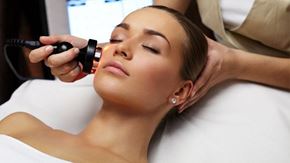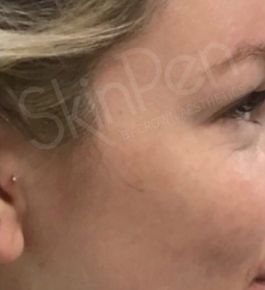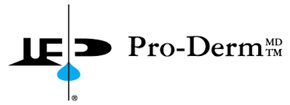Dermaplaning
Dermaplaning is a skincare procedure involving manual exfoliation to remove a layer of dead skin cells and fine vellus hair (also called peach fuzz), and is sometimes also known as epidermal leveling or “blading”. This treatment requires a skilled skin specialist to handle a sharp and sterile surgical blade, which gently glides over the skin at a 45-degree angle, drawing away all the dead skin cells and fine facial hairs, leaving the surface extremely smooth and radiant. As with any type of exfoliation, the removal of dead skin cells allows home care products to be more effective, and assists in reducing milia and minor breakouts associated with congested pores. Clean and smooth skin, free of dead skin cells and peach fuzz, allows for greater penetration of skincare products also creating a beautifully even surface for makeup to glide on flawlessly.
Peach fuzz can leave skin looking dull, as it traps oils and debris and leaves them clinging to the skin – once the fine hairs and dead skin cells are removed, your skin will feel fantastically clean and healthy. This treatment is an excellent way to exfoliate the skin and regenerate new skin cells, leaving the complexion smooth, soft, and vibrant. It is an extremely safe, painless, and effective treatment for most skin types - dermaplaning can also help to improve the appearance of acne-scarred skin and smooth out fine lines and wrinkles.
Some people are concerned that the removal of the vellus hairs (peach fuzz) will mean that the hair grows back thicker, coarser and darker. This is not the case, vellus hair cannot change into terminal hair (beard-type hair). As this is not a permanent method of hair removal, the hairs will regrow but only as the same vellus hair as before. Laser hair removal is not an option for very fine or light hair, so dermaplaning is one option to help towards a smooth, fuzz-free complexion.
Due to the contours of the face, certain areas such as the eyelids and nose are not treatable using this method.
The majority of clients receive noticeable, satisfactory to above average results with a series of treatments and a commitment to a daily skincare regime. However, this outcome cannot be guaranteed as maximum results are highly dependent on age, cumulative sun exposure, health, lifestyle, genetic traits, general skin condition, and willingness to follow recommended protocols.
After Treatment:
We take every precaution to ensure that your skin is well-hydrated and calm after treatment. However, some people may experience excessive dryness or even peeling between sessions – always contact us if you have any concerns.
More sensitive skins may experience some redness after treatment which usually subsides within 2-3 hours – again, if you have any concerns please contact the clinic.
After treatment, SPF 30 + must be worn at all times and tanning beds should never be used - you are making an investment in your skin, therefore it is to your benefit to continue to protect it long after your treatments are completed.
Post-Treatment Care:
Aerobic exercise/vigorous physical activity should be avoided until all redness has subsided. Direct sunlight exposure is to be completely avoided immediately following the treatment, including any strong UV light exposure or tanning beds. Although a sunscreen of at least SPF 30 should already be a part of your daily care, after dermaplaning SPF 30 + must be applied daily to the treated area for a minimum of two weeks.











